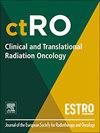IORT治疗早期低危乳腺癌:一项前瞻性观察性研究的结果
IF 2.7
3区 医学
Q3 ONCOLOGY
引用次数: 0
摘要
在过去的几年中,早期、低风险乳腺癌(BC)的治疗经历了显著的降级。targeit - a试验提供了术中放疗(IORT)作为一种方便的单组分方式的信息。然而,关于审判不同方面的重要讨论仍在继续。本研究报告了现实世界临床环境中的肿瘤结果,并有助于了解其最佳适应症。方法在2017年6月至2023年12月期间,对500例计划行保乳手术(BCS)的患者进行IORT筛查,进行前瞻性、观察性、单中心研究。治疗方案复制了targeit -a试验的实验部分,实施了更严格的纳入标准,并保持了一种适应风险的方法。主要终点是同侧乳房复发率(IBR)。次要终点包括局部无复发生存期、无进展生存期、总生存期和患者报告的美容。采用Kaplan-Meier法分析IBR的生存和复发风险,Cox回归分析IBR的危险因素。结果经过筛选和招募,464例患者进行了IORT。中位随访时间为45.3(8-89)个月。在整个队列中,估计5年IBR风险为1.7% (95% CI: 0.7% - 2.8%),在IORT +全乳照射(WBI)队列中下降至1% (95% CI: 0.3% - 2.4%)。在仅iort队列中,风险为2.1% (95% CI: 0.6% - 3.7%)。三个亚组间无显著差异。5年总生存率和乳腺癌特异性生存率分别为97.6% (95% CI: 96.0% - 99.1%)和99.5% (95% CI: 98.5% - 100%)。确定了IBR的两个独立显著危险因素:年龄和年龄;50岁(HR = 0.138, 95% CI: 0.032-0.597, p = 0.008)和手术缘闭合或受影响(HR = 5.8, 95% CI: 1.5-22.5, p = 0.011)。未见3-4级毒性事件的报道。患者报告的美容在84%的情况下是优秀/良好的。结论各组局部复发率均较低。通过采用比TARGIT A试验更严格的标准,可以获得更好的对照结果。需要更长的随访时间来证实我们的发现。本文章由计算机程序翻译,如有差异,请以英文原文为准。
IORT for early-stage, low-risk breast cancer: Outcomes from a prospective, observational study
Introduction
Treatment of early-stage, low-risk breast cancer (BC) has undergone significant de-escalation during the past years. The TARGIT-A trial provided information on intraoperative radiotherapy (IORT) as a convenient, single-fraction modality. Nevertheless, significant discussion regarding different aspects of the trial continues. This study reports on oncological outcomes in a real-world clinical setting and contributes to the understanding of its optimal indication.
Methods
Five-hundred patients planned for breast-conserving surgery (BCS) were screened for IORT between June 2017 and December 2023, within this prospective, observational, single-center. The treatment protocol replicated the experimental arm of the TARGIT-A trial, implementing stricter inclusion criteria and maintaining a risk-adapted approach. The primary endpoint was ipsilateral breast recurrence rates (IBR). Secondary endpoints included local recurrence-free survival, progression-free survival, overall survival, and patient-reported cosmesis. The Kaplan-Meier method was used to analyze survival and recurrence risk, and risk factors for IBR were assessed through Cox regression analysis.
Results
After screening and recruiting, IORT was performed in 464 patients. The median follow-up was 45.3 (8–89) months. The estimated 5-year IBR risk in the entire cohort was 1.7 % (95 % CI: 0.7 %–2.8 %), decreasing to 1 % (95 % CI: 0.3 %–2.4 %) in the IORT + whole breast irradiation (WBI) cohort. In the IORT-only cohort, the risk was 2.1 % (95 % CI: 0.6 %–3.7 %). No significant differences were observed among the three subgroups. The 5-year overall survival and breast cancer-specific survival rates were 97.6 % (95 % CI: 96.0 %–99.1 %) and 99.5 % (95 % CI: 98.5 %–100 %), respectively. Two independent significant risk factors for IBR were identified: age < 50 years (HR = 0.138, 95 % CI: 0.032–0.597, p = 0.008) and close or affected surgical margins (HR = 5.8, 95 % CI: 1.5–22.5, p = 0.011). No grade 3–4 toxicity events were reported. Patient-reported cosmesis was excellent/good in 84 % of cases.
Conclusions
Local recurrence rates were low amongst all groups. Superior control outcomes could be obtained by applying more restrictive criteria than the TARGIT A trial. Longer follow-up is needed to confirm our findings.
求助全文
通过发布文献求助,成功后即可免费获取论文全文。
去求助
来源期刊

Clinical and Translational Radiation Oncology
Medicine-Radiology, Nuclear Medicine and Imaging
CiteScore
5.30
自引率
3.20%
发文量
114
审稿时长
40 days
 求助内容:
求助内容: 应助结果提醒方式:
应助结果提醒方式:


